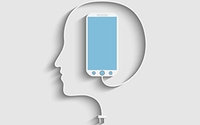Commentary
Forget Viewability - Nielsen Study Shows What's On Mobile Users' Minds
- by Tyler Loechner , Staff Writer @mp_tyler, March 11, 2015
 Native ads on mobile sites receive twice
as much “visual focus” from consumers compared to banners on mobile devices, according to a new Sharethrough-commissioned Nielsen study.
Native ads on mobile sites receive twice
as much “visual focus” from consumers compared to banners on mobile devices, according to a new Sharethrough-commissioned Nielsen study.
The results were gathered after a year-long study of how consumers “visually processed” mobile ads. Nielsen’s Neuro lab used eye-tracking technology and neuroscience to track subconscious brain signals during tests.
For the study, Nielsen compared native ads and banner ads, both placed in-feed. Working with five different advertisers, including Boeing, mock ads were created using “similar creative elements that were optimized for each format,” Sharethrough, a native ad exchange, writes in a summary of the report.
“Study participants were shown a video simulating the experience of scrolling through an editorial feed. The feed is paused and the participant is shown either a native ad or an in-feed banner.” Nielsen then “quantified where and how the participants’ focus was being directed.”
As noted, the study found that native ads received twice as much “visual focus” compared to banner ads. The study also found that banner ads are processed more peripherally (“little-to-no visual focus on the text”) compared to native ads. For native ads, consumers focused more on the text of the ad than the thumbnail.
A total of 146 consumers took part in the eye-tracking test, and 226 took part in the electroencephalogram (EEG) test. The companies assert this is a standard sample size for both eye-tracking and EEG tests. As for a margin of error, Nielsen says the EEG metrics are “reported at a 95% confidence level.”
It’s the second time this week that neuroscience data has been highlighted in a report -- both of which were tied to Nielsen. Marketers are now learning more about how consumers subconsciously react to content and advertising. Programmatic ad platforms fueled by neuro-data may not be far off.
Eye-tracking technology also made waves last week, when Sticky, an eye-tracking firm, claimed to come up with a new way to lower the cost of using eye-tracking technology to run tests.
The entire conversation revolves around understanding whether consumers are paying attention to ads, which is the fire underneath the viewability debate, as well.
In a recent conversation with Real-Time Daily, Integral Ad Science CEO Scott Knoll said that viewability is not just a piece of the metrics puzzle. Rather, it is the table on which the puzzle is being built. Knoll also contended that “once viewability challenges are overcome satisfactorily, other measurement metrics will play a bigger role.”
Perhaps we are seeing the start of those other measurement metrics, and marketers are going straight to the source: brainwaves.




Great insight. Beyond design, mindset matters. Relevant messages tend to get noticed. Effective advertising -- native or otherwise -- gets welcomed into consumers' consciousness when a message appears during the consideration window and is relevant to how someone is thinking. Curious whether Sharethrough's mock ads were contextually-aligned with content (articles or feeds) on the sample web pages used in the study.
Hi Jason,
I completely agree. The mindset of the consumer and context in which the ad is being read is key - this is where good targeting comes in (both the targeting of interested consumers and the relevancy of the placements themselves).
In our research, all consumers were screened for particular characteristics to mimic our targeting capabilities and editorial posts were chosen to most represent the mock site.
For us, what is most fascinating about this research is its implications for the creative decisions involved. Not only are we able to capture user attention by being native to the user experience, but ultimately we can use neuroscience to educate ourselves on how to capture a persons imagination while they're reading through a feed.
Surprise! Surprise!
The research keeps stacking up about the importance of creative over big data media placement yet few seem to really be getting it. comScore has said better creative will be 4x more effective than the best media placement yet we still have an ocean of companies trying to sell us better data... How about showing a little prowess and provide a little of both?
Gene, you're spot on! This is what I was looking for AT f8 this week. I think Facebook gets the whole creative + data makes for a sweet mobile ad experience. Airpush gets it, as their Abstract Banners certainly reflect that understanding. I'm not convinced Google doesn't know this, I just don't see them caring enough to act on that understanding. Perhaps once they've lost more mobile ad market share to Facebook, Yahoo and others they will get back to coming up with creative ads/banners that deliver more relevant content. But we're not dependent on Google any more for mobile ad innovation. There's enough of that going around the vast mobile ad landscape today. http://www.allvoices.com/article/100003599